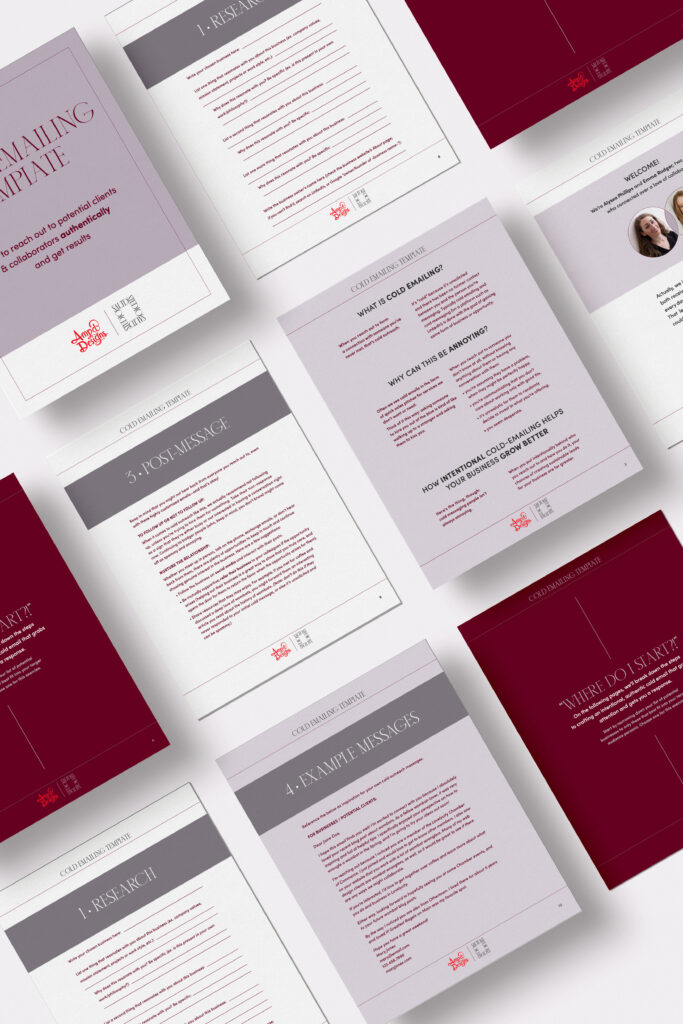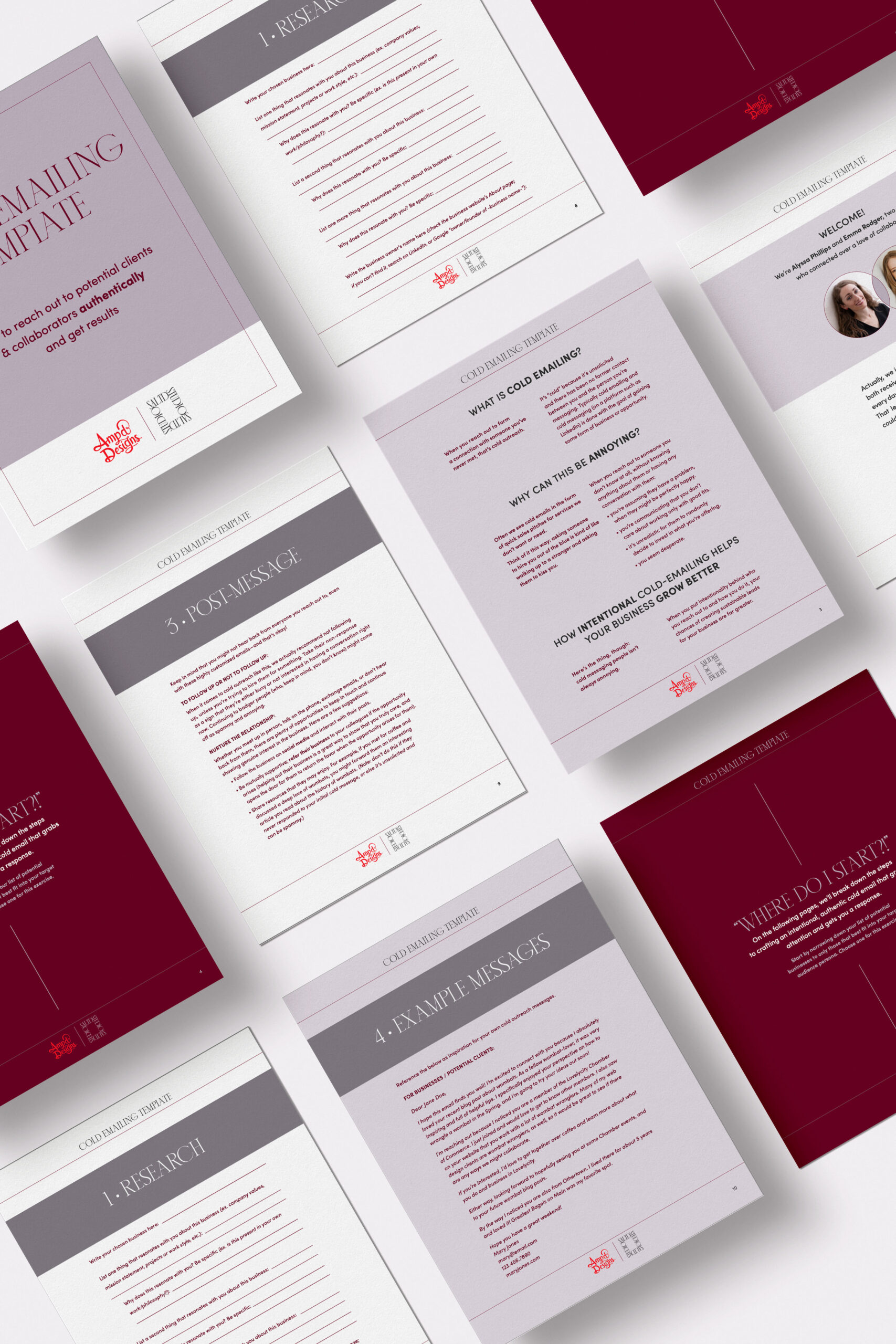Uncovering the Best Emailing Strategies with Alyssa Phillips
Let’s face it, reaching out to grow your network or business via cold calls, emails or DMs can feel awkward and… well… cold! There’s a lot of advice out there on generating new leads or opportunities, and cold emailing often gets a bad rap, but I’d argue that’s because it takes a strategy to cold email effectively and see results.
The cold truth: cold emails aren’t ALL bad! As business owners, we get dozens of spam-y and sales-y emails every week. Many pop into an inbox in the form of a sales pitch. But, some of those actually resonate and convert. So, if a goal of yours is to scale your business, how can you reach out to people authentically? How can you send emails that actually generate the opportunities that you’re going for?
My friend and fellow design business owner Alyssa Phillips of Amp’d Designs and I dug deep into this topic to identify what specifically makes a cold email “cold” and off-putting, versus what helps build relationships that grow your business.
First, we looked into the history of cold emails: The exact background is a bit hazy, but it’s clear that cold emailing stems from general cold sales practices. Remember going door-to-door to sell wrapping paper or cookies? Before the internet, business owners used similar strategies along with cold calling to promote their services and products. The first cold call dates back to 1873! With the growth of technology, the way business owners network and keep in touch has continued to evolve.
In this blog post, Alyssa chatted with me about her hot takes on cold emailing, why it’s so widely used today, and how to structure a cold email. Let’s dive in!
Q: Why are cold-sales emails annoying?
Put yourself in the shoes of the person on the other side. Remember all the times you’ve answered a phone call that ended up being spam about loans or health insurance or winning a contest? Aren’t those so annoying?!
That’s basically what you’re doing to people when you cold email or cold message them a sales pitch.
Pitching your services to someone out of the blue is like walking up to someone on the street and asking them to kiss you. It’s expecting them to make a huge commitment when they don’t even know or trust you yet.
To put it bluntly, cold sales messages come across as:
- Careless, because you’re not putting any time or effort into building a relationship
- Disrespectful, because you’re sending someone a message they don’t want, in an era where people are constantly inundated with media they’re not looking for
- Presumptuous, because you’re making assumptions about what a business needs or wants without knowing any details
- Desperate, because it comes across like you’re begging for work instead of naturally building relationships
Q: Is there a cold email that comes to mind that you found insincere?
Recently I received a LinkedIn connection request from another designer. Typically I don’t connect with people I don’t know on LinkedIn, but we had some mutual connections, and since he was also a designer I thought it would be a good opportunity to connect and mutually support one another.
After I accepted the request, the designer immediately sent me a message pitching his web design services to me. I was shocked, because obviously as a web designer myself I’m not in the market for web design services!
Often I see situations like this as an educational opportunity, especially when it comes to young designers. So I responded to his message with a kind and lighthearted note that I’m not the intended audience, and if he had looked into my business even just a bit he would have realized that. I recommended he do a bit more research before contacting people in the future and explained that creating more personalized messages for each business owner would likely help him get more responses.
I heard nothing back until a few weeks later when he sent me another message that said, “I wanted to follow up on my earlier request. When we last spoke, you seemed very interested in our website design service. Would you be interested in a call? Really looking forward to working with you.”
Internally I rolled my eyes hardcore. Did he even read my original response? Or had he sent so many of these messages that he just forgot? Either way, it came across as very negligent and rude. Not to mention, ending a sales pitch with, “looking forward to working with you,” is incredibly presumptuous when there’s absolutely no indication from the other person that working together might happen.
Q: Why is this method still used if so many people find it off-putting?
I would love to know, ha! But seriously— I Googled “does cold emailing work” and was astounded to find so many articles recommending not just cold emailing, but the super spammy kind of cold emailing. This emoji about sums up my reaction: 🤦♀️
There are a few reasons that people do this:
- Small business owners and solopreneurs cold pitch when they are new to freelancing or experiencing a dip in business. They don’t have a solid brand strategy that helps them get in alignment with their goals and audience and see this as a way to attract more leads.
- Students and recent grads looking for work receive advice to send cold emails. While this isn’t all bad, it often ends up taking the form of an impersonal template that they copy-paste to tons of businesses, which makes it off-putting.
- Some industries are much less focused on personal relationships, and transactional sales do work better for them and their audience.
- The advice to send these types of cold emails is still out there, and people report on the one or two times that it worked while ignoring the hundreds of emails they sent that got no response.
I imagine that back when cold-emailing was a shiny new thing, it was more effective. Just like telemarketers had their time, as did door-to-door salesmen. But the reality is that spam emails are out of control now, so a cold pitch just gets lost in the sea of marketing chatter and infuriating targeted ads. Nobody wants to receive sales pitches they didn’t ask for and that they can’t unsubscribe from.
The thing is, building genuine relationships is hands down the best form of marketing for any business. But let’s face it, building relationships take time. It most likely isn’t going to get you a bunch of new leads overnight. It takes months of networking and nurturing connections to get to a point where relationships start to pay off. I think a lot of business owners—especially when they’re new or experiencing a dip—don’t have or don’t want to take the time. Cold emailing is easier. But the payoff of long-term relationships is far greater and much more sustainable for your business.



Q: What specifically makes an email feel less “cold” and more “connection-oriented”?
There are two things that make a cold email feel more approachable:
- It’s personalized
- It’s focus isn’t on hard selling
Personalized:
It is very easy to tell when a message is copy-pasted and sent to hundreds of businesses. Simply swapping out the recipient’s name isn’t enough.
An email seems more connection-oriented when it’s clear that the sender put time into checking out the recipient’s website and learning about their business. This means that the sender cites specific things about the business that resonate with them, and expresses a genuine interest in getting to know the business beyond selling to them.
Easy ways to do this are to cite a few of the business’s core values that resonate with you and why. Or peruse their About page and see if you can relate to something they’ve written; for example, if you’re both from the same city or have the same hobby, those are great things to point out and elaborate on.
Adding personal touches like this tells the recipient that you did your research and that you care about a true connection with them beyond just taking their money.
Focus:
Remember, asking someone to buy from you in the first email is like walking up to someone and asking them to kiss you! It’s not a realistic expectation.
The focus of your first email shouldn’t be selling; it should simply be on connection. A spammy first email’s call to action is to book a call to learn more about your services. However, a connection-oriented first email’s call to action is to get to know each other so that your relationship can be mutually beneficial.
The latter call to action looks like asking them for a Zoom call to get to know more about what the business does or asking a local entrepreneur to meet for coffee to share experiences of running a business. Yes, you can talk about the work you do during these meetings, and of course, you should elaborate if the business genuinely seems interested in your services, but overall the focus is not to corner them into a sales pitch. It’s to form a connection.
It’s unlikely that many businesses you reach out to will need your services immediately. The goal is to be the person they think of when they do need you because you seemed like a genuine human being.
While not always possible, it’s worth noting that a cold email also seems less “cold” if there has already been some interaction building up to the email, such as smaller communications with each other on social media. Through smaller interactions, you can get a sense of if someone does truly fit into your target audience and if they do actually have a problem that you can help them solve. This also gives you a much better basis for writing a personalized email.
Q: What are some ways cold emailers can add value and actually help those they reach out to right within the first or second email?
Honestly, it’s never really appropriate to send people resources they didn’t ask for out of the blue. Just because you think something will be valuable to a business doesn’t mean they will see that value. This all goes back to really being selective about who you reach out to and looking for those best-fits.
The most valuable thing in a cold email is showing a genuine interest in the business, and an invitation to a conversation that builds a mutually-beneficial relationship.
Q: Why should a business be selective about who they cold email?
Every business owner has heard that “everyone is not your client.” It’s imperative to understand who your audience is on a deep level, beyond simply “anyone who owns a house” or “anyone with a website.” And it’s even deeper than demographics. Think about the qualities of your ideal customer. What personality traits and characteristics make someone a good fit for you?
The only way you can qualify leads is by having a real conversation with them. So mass-sending cold pitches completely disregards actually vetting good fits. It instead communicates that you don’t care about relationships and you’ll work with just anyone. And that’s not a great look.
Taking the time to be selective about who you reach out to also saves you way more time because it allows you to focus on sending personalized emails to only best-fit potential clients and spend more time nurturing those relationships.
Q: Have you ever received a cold email that you responded to, and if so, what made you respond?
Aside from the designer on LinkedIn I mentioned above, the only time I have responded to cold emails is when they’re from students seeking jobs or internships.
I’ve been in the shoes of a young designer needing experience, and I know what it’s like to hunt for jobs. Education is also very important to me, as is lending a hand to one another in the design community. I have a great appreciation for professors, mentors, and colleagues who helped me learn professional practices. For that reason, I usually respond to copy-paste-sounding messages from young designers with tips on how to write a personalized cold email that gets them responses!
I should note that I also respond to “cold emails” that are connection-oriented, and I’ve sent plenty of them myself. As we’ve discussed, though, these are very different from the spammy cold emails we’ve been discussing.
Q: Are there any specific email structures or wording that you would recommend for students or recent grads seeking jobs and internships?
In general, the personalization mentioned above is still key, and the tips in our free downloadable resource (linked below!) are all still applicable.
Some specific tips for students and recent grads are:
- Check the job posting or company website for instructions. Some companies ask students to include specific info in their job inquiries. You don’t want to get eliminated just because you didn’t read the instructions!
- Explain why you’re interested in this company specifically. Cite some things that stand out about their work, values, or company culture that you personally relate to, and state why you believe you’re a good fit to work with them based on these things.
- Talk about your education, any relevant experience, and a bit about your work and philosophy.
- Express gratitude for their consideration and excitement about the possibility of talking more.
- If you don’t hear back from your initial email, follow up 1 week later. You may also send a second follow-up a week or so after that.
Q: How can people reach out to potential customers without being spammy?
So we’ve just covered all the reasons cold-emailing is spammy. But that actually doesn’t mean you can’t contact any strangers ever! You just need to be intentional and connection-oriented when you do it.
- Research businesses before reaching out, and only contact those who seem like potential best-fits.
- DON’T copy-paste emails. Write a custom, personalized email to each business.
- Show genuine interest in getting to know them beyond selling them your services.
Now It’s Your Turn!
Get your template & guide
Phew! Alyssa and I uncovered a lot about what not to do, but we also want to provide some actionable and valuable next steps for business owners – so you can cold email effectively. After all, not ALL cold emails are bad, right?! That’s why we created a free downloadable resource that includes the formula for crafting authentic cold messages that work.
Get your Cold Emailing Template & Guide here!
Lastly, if you’re curious about my hot takes on cold emailing, check out Alyssa’s interview with me over on her blog here!
About Alyssa and our collab
Alyssa and I connected on Instagram and quickly became long-distance business besties. What started as a mutual vent session about the cold emails turned into a shared goal of providing resources and a deeper understanding of how to go about sales as small business owners. Since working together on the “Our Hot Takes on Cold Emailing” series, Emma and Alyssa have become supporters of each other as founders and may have plans to launch more resources in the future (stay tuned!). If you want to be the first to know about future collaborations (and recipes we love, real-life biz owner encouragement, and more), sign up for both of our newsletters!: Alyssa’s | Emma’s

Alyssa Phillips owns Amp’d Designs, based in Asheville, NC, working with passionate small businesses and entrepreneurs to help them amplify their voices through branding, web design, and brand strategy. Alyssa believes that design is a collaboration, and should communicate the unique values and story of each business in order to connect authentically with its customers. She also helps designers build sustainable and fulfilling graphic design businesses.
